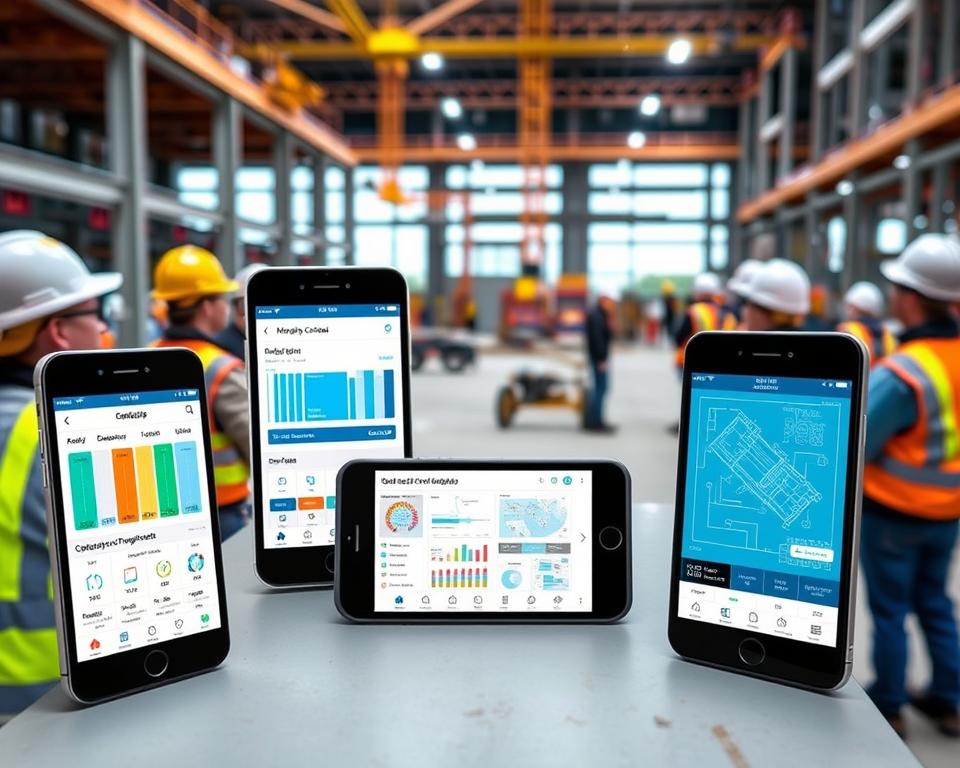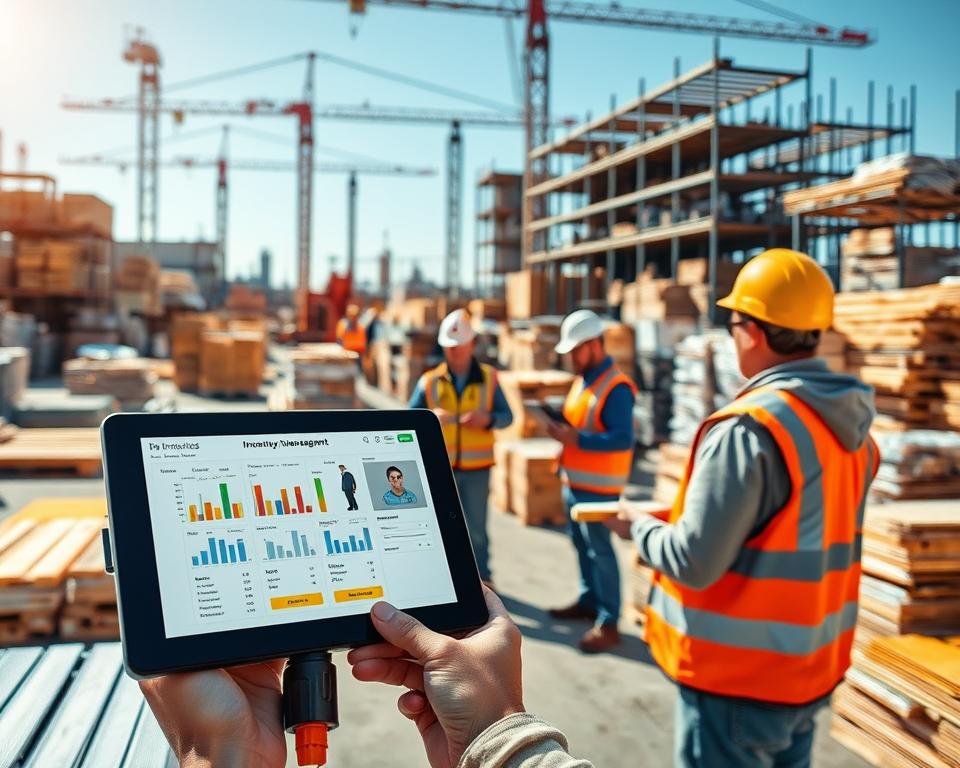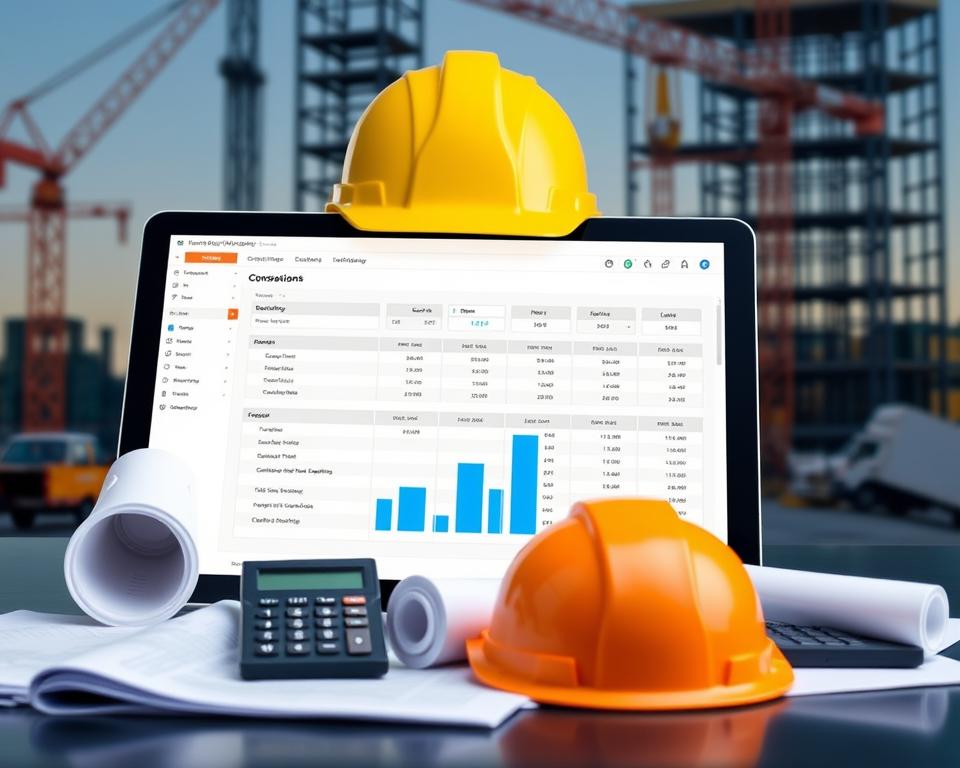The construction industry is changing fast, thanks to mobile apps. These apps help make work easier, improve how projects are managed, and boost efficiency. It’s now more important than ever to have apps made just for construction.
Creating an app for construction needs a deep understanding of the industry’s challenges. This includes knowing what construction workers and managers need most.
In this guide, we’ll look at the key features and tools for a great construction app. We’ll cover project management, safety, document handling, and keeping in touch in real-time. These are the must-haves that can change how construction work is done.
By using mobile tech, construction companies can work better, make fewer mistakes, and finish projects faster. This is how they can improve their work and meet deadlines.
Table of Contents
Key Takeaways
- Understand the construction industry’s digital transformation needs and the current technology gaps
- Identify essential features for construction industry mobile apps, including project management, safety compliance, and document management
- Explore the importance of real-time communication, equipment and material tracking, and budget management
- Learn about the integration capabilities with existing construction software and the importance of mobile app security
- Discover the strategies for user interface design, testing, and ongoing app maintenance and updates
Understanding the Construction Industry’s Digital Transformation Needs
The construction industry is changing fast. It used to be slow to adopt new tech, but now it sees the need for digital change. The construction technology gaps are big, making things less efficient and less competitive. But, companies are starting to use new digital tools to fix these problems and change for the better.
Current Technology Gaps in Construction Management
The construction world has long used old, paper-based ways. It has also had trouble with data and communication. These construction technology gaps cause delays, extra costs, and bad teamwork. Fixing these issues is key for the industry to keep up with new market needs.
Digital Solutions Impact on Construction Efficiency
Digital tech like project management software and BIM can change the game. These digital solutions make things run smoother by sharing data fast and helping make better choices. As the industry goes digital, it will see big improvements in how things get done.
Market Demand for Construction Apps
There’s a big need for construction apps in the market. These apps help with planning, scheduling, and safety. As the app market grows, companies see the value in using these tools to improve and stay ahead.
Essential Features for Construction Industry Mobile Apps
Mobile apps are key for construction pros today. They help tackle the industry’s unique challenges. These apps need to have features that meet construction project needs.
Project management and scheduling are vital. They include assigning tasks, managing timelines, tracking progress, and allocating resources. These tools help teams work better together and finish projects on time.
Safety and compliance are also crucial. Construction sites are dangerous, and apps can help keep workers safe. They offer tools for safety checks and reporting incidents.
- Document management tools are essential. They handle blueprints, contracts, and reports efficiently.
- Real-time communication tools help teams share info and make decisions quickly.
- Equipment and material tracking solutions optimize resource use and reduce downtime.
Apps should also manage budgets and control costs. They should have quality control tools to ensure work meets standards.
| Essential Features | Benefits |
|---|---|
| Project Management and Scheduling | Streamline workflows, enhance collaboration, and ensure timely project completion |
| Safety Compliance and Inspection | Maintain a safe work environment and ensure regulatory compliance |
| Document Management and Digital Documentation | Efficient information handling and compliance requirements |
| Real-time Communication and Collaboration | Seamless information sharing, decision-making, and coordination among stakeholders |
| Equipment and Material Tracking | Optimize resource utilization and minimize downtime |
| Budget Management and Cost Control | Maintain financial control and ensure project profitability |
| Quality Control and Inspection | Maintain high standards of workmanship and project quality |
With these features, construction apps can help professionals work more efficiently. They improve project results and drive digital change in the industry.
Project Management and Scheduling Capabilities
Construction projects are getting more complex. This makes it crucial to have strong project management and scheduling in construction apps. These tools help professionals work better, be more efficient, and finish projects on time and budget.
Task Assignment and Timeline Management
Good construction apps need to manage tasks and timelines well. They should let you assign tasks to team members, set deadlines, and track progress. This way, managers can spot problems early and adjust plans.
Progress Tracking Systems
Tracking progress is key to managing construction projects. With the right apps, teams can see how work is going. This helps spot delays and fix issues quickly.
Resource Allocation Tools
Managing resources well is vital for a project’s success. Construction apps should help allocate labor, equipment, and materials. This ensures the right resources are used at the right time, saving time and money.
| Feature | Description | Key Benefits |
|---|---|---|
| Task Assignment and Timeline Management | Ability to assign tasks to team members, set deadlines, and visualize project timelines | Improved coordination, identification of potential bottlenecks, and proactive schedule adjustments |
| Progress Tracking Systems | Real-time visibility into the completion of critical milestones and ongoing work | Enhanced project oversight, early issue detection, and timely interventions |
| Resource Allocation Tools | Efficient allocation of labor, equipment, and materials based on project demands | Optimized resource utilization, reduced waste, and increased productivity |
By adding these features, construction apps can help teams work better together. They can manage projects more efficiently and make them more profitable.
Safety Compliance and Inspection Features
The construction industry is changing fast, and safety apps are key. They help keep workers safe and follow the rules. These apps track safety, do digital inspections, and keep work areas safe.
Compliance tracking is a big deal in these apps. Managers can check if they’re following safety rules like OSHA’s on their phones. This makes it easy to keep up with safety rules and avoid fines.
- Real-time tracking of safety incidents and near-misses
- Automated alerts for safety violations or non-compliance
- Customizable safety checklists and inspection forms
Digital safety inspections are another important feature. Workers use their phones for inspections instead of paper. This makes sure all data is saved and can be used later for reports.
“Construction safety apps empower our team to identify and address potential hazards quickly, ensuring the well-being of our workers and compliance with industry standards.”
Using construction safety apps has changed the game for many companies. They make safety easier, lower accident risks, and keep workers safe. This helps companies avoid legal trouble and promotes a safe work environment.
Document Management and Digital Documentation
The construction industry is always changing. Now, it’s all about efficient document management and digital documentation for success. Construction apps are making it easier for professionals to work better, thanks to new features that tackle the field’s challenges.
Blueprint and Drawing Management
Construction apps are great at managing digital blueprints and drawings. They let users access, view, and work on construction documents from any device. This means no more physical storage and fewer version control problems.
Contract and Permit Processing
Handling permit processing and contract management can be tough and prone to mistakes. But, construction apps with contract and permit processing features make it easier. They help track approvals, manage deadlines, and keep up with regulations.
Digital Forms and Reports
Construction apps are changing how we handle important info. They let users make, share, and work on digital forms and reports. This makes construction document management faster and cuts down on paper use.
Using construction document management apps can really help. It makes work more efficient, improves teamwork, and keeps information flowing smoothly throughout a project.
Real-time Communication and Collaboration Tools
In the fast-paced construction industry, effective communication and collaboration are key to success. New software is changing how construction teams work together. They can now share information and coordinate their efforts more easily.
These tools give construction teams a central place to work together better. They help companies manage projects and share files in real-time. This way, team members can work together, no matter where they are.
- Real-time project updates: Construction collaboration software offers features that allow team members to receive instant notifications on project status, task progress, and any changes or updates.
- File sharing and document management: These tools enable construction professionals to securely store, access, and share project documents, blueprints, and other crucial files from a single, centralized platform.
- Task assignment and coordination: Collaboration software facilitates the efficient assignment of tasks, deadlines, and responsibilities, ensuring all team members are aligned and working towards common goals.
Construction companies can improve by using these tools. They help break down barriers and make information flow better. This leads to more efficiency, fewer mistakes, and better results for clients.
| Feature | Benefit |
|---|---|
| Real-time project updates | Keeps all team members informed of the latest project status, changes, and progress |
| File sharing and document management | Enables seamless access and collaboration on project files and documents |
| Task assignment and coordination | Ensures efficient task management and alignment among construction team members |
By harnessing the power of real-time communication and collaboration tools, construction companies can unlock new levels of productivity, streamline their workflows, and deliver exceptional results for their clients.
Equipment and Material Tracking Solutions
In the construction world, tracking equipment and materials well is key to success. Using digital tools for inventory management, tracking, and supply chain integration can change how construction works. These tools help teams work better, cut down on lost time, and improve project management.
Inventory Management Systems
Construction apps with good inventory management systems offer real-time views of materials. This lets teams see what’s available, where it is, and how it’s being used. It helps them make smart choices, buy materials wisely, and cut down on waste. Adding barcode scanning or RFID technology makes tracking even more accurate and efficient.
Equipment Maintenance Scheduling
Construction equipment is vital for any project, and keeping it in good shape is crucial. Apps that track equipment can schedule maintenance, send reminders, and keep detailed logs. This keeps equipment running smoothly, cuts down on downtime, and makes sure it’s always ready to work.
Supply Chain Integration
Working well with supply chain software is another great feature for construction apps. Connecting with suppliers and logistics companies gives teams a clear view of the supply chain. They can track deliveries, plan shipments, and handle any supply chain issues. This keeps resources flowing smoothly to the job site.
| Feature | Benefits |
|---|---|
| Construction Inventory Management | Improved visibility, reduced wastage, and optimized material procurement |
| Equipment Tracking | Proactive maintenance, reduced downtime, and enhanced productivity |
| Supply Chain Integration | Streamlined logistics, enhanced visibility, and better coordination with suppliers |
By using these tracking solutions, construction companies can make their operations more efficient. They can use resources better, improve project delivery, and boost profits.
Budget Management and Cost Control Features
The construction industry is changing fast, and managing budgets and costs is key. Construction apps now help project managers keep track of expenses and stay on top of finances. They also help manage resources well throughout a project.
Good construction budget software and cost control apps have many useful features. These include:
- Real-time budget tracking: This lets project managers see budgets, expenses, and funds easily. They can make smart decisions and adjust plans when needed.
- Cost forecasting and analysis: These tools use past data and analytics to predict costs. They help spot potential overruns and find ways to save money.
- Expense management and invoicing: These apps make it easy to track and approve expenses. They also help send out invoices to clients and vendors.
- Resource allocation and optimization: These apps help manage labor, equipment, and materials. They ensure these resources are used well and waste is kept low.
- Reporting and data visualization: These apps create detailed reports and visualizations. They give everyone a clear picture of the project’s financial health.
| Feature | Benefits |
|---|---|
| Budget Tracking | Real-time visibility into project budgets, expenses, and remaining funds |
| Cost Forecasting | Predictive analytics to identify potential cost overruns and implement proactive measures |
| Expense Management | Streamlined process for recording, approving, and invoicing expenses |
| Resource Optimization | Efficient allocation and management of labor, equipment, and materials |
| Reporting and Analytics | Comprehensive financial insights and data visualizations for project stakeholders |
By using these financial management in construction features, construction companies can stand out. They can make more money and work more efficiently.
“Effective budget management and cost control are essential for the success of any construction project. Construction apps that prioritize these features are invaluable tools for project managers in the industry.”
Quality Control and Inspection Checklists
The construction industry is always changing. Using technology to improve quality control and inspections is key. Construction apps with strong quality control and inspection tools can make projects better, lower risks, and follow industry rules.
Quality Assurance Protocols
Good construction apps have detailed quality assurance plans. They help project managers and site supervisors set clear quality control rules. These plans include checklists, inspection rules, and ways to report issues quickly.
Defect Tracking Systems
Adding defect tracking software to construction apps lets teams track and manage defects. This helps solve problems fast, spot trends, and fix issues before they happen again.
Compliance Monitoring Tools
Following industry rules, safety standards, and environmental laws is vital in construction. Apps with compliance monitoring tools help teams stay on track. They automate paperwork and make sure all rules are followed.
| Feature | Benefit |
|---|---|
| Construction Quality Control | Ensures projects meet quality standards and specifications |
| Defect Tracking Software | Streamlines issue identification, resolution, and trend analysis |
| Compliance Monitoring Tools | Supports adherence to industry regulations and safety guidelines |
“Investing in robust quality control and inspection features for construction apps can significantly enhance project outcomes, reduce costs, and ensure compliance with industry standards.”
How to Build an App for the Construction Industry: Features and Tools
Creating a mobile app for construction needs deep knowledge of the industry. The construction app development process requires careful planning and choosing the right features. It’s about making a tool that truly helps construction pros.
A good construction app has key features for managing projects, improving safety, and making work flow better. These features might include:
- Easy project scheduling and task assignment
- Tools for tracking progress and managing resources in real-time
- Systems for managing documents like blueprints and contracts
- Features for team communication and collaboration
- Tools for tracking inventory and equipment
- Systems for managing budgets and controlling costs
- Checklists for quality control and monitoring compliance
To make these features work, developers use a variety of app building tools and technologies. From frameworks for building apps on different platforms to cloud storage for data, each tool is important. They help create an app that is easy to use and works well together.
| Feature | Description | Key Tools |
|---|---|---|
| Project Management | Streamline project planning, scheduling, and task assignment | Gantt chart builders, calendar integrations, AI-powered task assistants |
| Document Management | Centralize and digitize construction documentation | Document scanning apps, cloud storage platforms, electronic signature tools |
| Communication and Collaboration | Foster real-time coordination and information sharing | Messaging apps, video conferencing tools, file-sharing platforms |
| Inventory and Asset Tracking | Manage equipment, materials, and supply chain logistics | RFID sensors, GPS tracking, barcode scanners |
By carefully choosing and integrating these construction app development features and tools, construction companies can become more efficient, safe, and profitable. This puts them in a strong position in the changing digital world.
“The construction industry is undergoing a digital transformation, and mobile apps are at the forefront of this change. Investing in the right features and tools can give construction firms a competitive edge.”
Integration Capabilities with Existing Construction Software
The construction industry is moving towards digital transformation. This means it’s more important than ever for mobile apps to work well with existing software. Construction workers need construction software integration to make sure their apps and tools work together smoothly.
One big advantage of app compatibility is that it lets data flow easily between different systems. By linking with current construction management software, mobile apps can share project data, documents, and updates in real-time. This cuts down on manual entry and reduces errors.
- Streamlined data transfer between mobile apps and desktop software
- Automated synchronization of project schedules, task assignments, and progress reports
- Seamless exchange of blueprints, drawings, and other construction documents
Strong integration also lets construction pros get the most out of their software. It creates a unified and efficient digital environment. By connecting mobile apps with desktop apps, companies can boost productivity, teamwork, and decision-making with a full view of project data.
“Integrating our mobile app with our existing construction management software has been a game-changer, allowing our teams to work more efficiently and collaborate in real-time.”
As the construction world keeps changing, being able to link mobile apps with existing software will be key. It will drive digital transformation and help projects succeed.
Mobile App Security and Data Protection
In the construction world, keeping sensitive data safe is key. Workers need secure digital tools to protect their work and client info. By using strong user authentication, data encryption, and cloud storage security, apps can lower the risk of data breaches.
User Authentication Methods
Strong user authentication is the first step in keeping apps safe. Using multi-factor authentication, like passwords and biometrics, boosts security. Secure single sign-on (SSO) solutions also make logging in easy and safe for workers.
Data Encryption Standards
Keeping construction data safe is essential. Apps should use top-notch encryption, like AES-256 or RSA encryption, to protect data during and after it’s sent or stored.
Cloud Storage Security
Cloud solutions have changed the construction game, making teamwork and data access easy. But, cloud storage security is a big deal. Apps should use secure cloud providers with strong access controls, encryption, and backups to keep data safe from breaches or loss.
By focusing on these security areas, construction firms can win trust, follow rules, and keep data safe. These steps help workers confidently use digital tools, reducing risks in the mobile app world.
User Interface Design for Construction Professionals
The construction industry is changing fast, and mobile apps play a big role. These apps need to be easy to use and help workers do their jobs better. A good design makes sure the app is both useful and easy to navigate.
Creating a great UI for construction apps means knowing the industry well. It’s about understanding how workers use technology every day. By focusing on construction app UI design and user experience in construction software, developers can make apps that help workers do their jobs better.
Key Principles for Construction App UI Design
- Simplicity and Clarity: The UI should be clean and easy to use. It should let users find what they need fast, without getting lost.
- Task-Oriented Approach: The app should focus on the main tasks of construction workers. This makes it easy for them to do their jobs well.
- Offline-First Functionality: Since construction sites often have no internet, the app should work well offline. It should also sync data well when it does have internet.
- Optimized for Mobile Use: The app should be made for mobile devices. It should have big buttons, clear icons, and easy gestures for workers on the move.
- Contextual Alerts and Notifications: The app should send alerts and notifications that are timely and relevant. This keeps construction teams informed and up-to-date.
By following these principles, developers can make intuitive app interfaces for construction professionals. These apps will improve user experience in construction software and help workers do their jobs more efficiently.
| Feature | Benefit |
|---|---|
| Simplified Navigation | Allows construction workers to quickly access the information they need, reducing frustration and improving efficiency. |
| Task-Oriented Design | Aligns the app’s functionality directly with the core workflows and responsibilities of construction professionals, enhancing productivity. |
| Offline Capabilities | Ensures construction teams can continue working seamlessly, even in areas with limited connectivity, minimizing disruptions. |
| Mobile Optimization | Provides an intuitive and user-friendly experience on the go, catering to the needs of construction workers in the field. |
| Contextual Alerts | Keeps construction teams informed and responsive to critical project updates, promoting better coordination and decision-making. |
Testing and Quality Assurance Processes
Creating a solid construction app needs careful testing and quality checks. These steps include beta testing, performance tweaks, and using user feedback. They make sure the app works well and is easy to use.
Beta Testing Strategies
Before releasing a construction app, beta testing is key. It involves getting a variety of construction workers to try the app. They give feedback that helps fix problems and improve the app.
Performance Optimization
For construction pros, a fast app is crucial. They need quick access to project info and smooth workflows. To improve this, developers use code tweaks, data caching, and cloud services. This makes the app fast and reliable.
User Feedback Integration
User feedback is vital for improving construction apps. By listening to users, developers can make the app better. They can add new features and fix issues to meet construction needs.
“Comprehensive testing and quality assurance processes are essential for building a construction app that construction professionals can truly rely on.”
App Maintenance and Updates Strategy
Keeping a construction app up to date is key for its relevance and security. A good construction app maintenance plan helps professionals keep their tools efficient. It also supports continuous improvement in their projects.
Regular software updates fix bugs, improve user experience, and add new features. Developers should listen to user feedback and analyze data. This way, they can make timely updates that keep the app useful.
| Key Considerations for Construction App Maintenance | Benefits |
|---|---|
|
|
A thorough construction app maintenance plan keeps digital tools reliable. It makes them essential for managing projects. This leads to better efficiency, safety, and profits.
Effective app maintenance is not a one-time event, but an ongoing process that requires a proactive and adaptable approach to ensure the long-term success of construction technology investments.
Conclusion
The construction industry has seen a big change thanks to new technology. Mobile apps are making things more efficient, safe, and collaborative. These apps offer great tools for managing projects and keeping everyone in touch.
Looking ahead, the success of digital change in construction depends on leaders embracing new tech. By creating detailed construction apps, companies can lead the way. They’ll see better productivity, cost control, and safety.
The path to a more digital construction world has its hurdles. But the opportunities for growth and innovation are huge. With the right tools, construction pros can achieve more efficiency, teamwork, and customer happiness. This will make the future of construction brighter and more exciting.


















